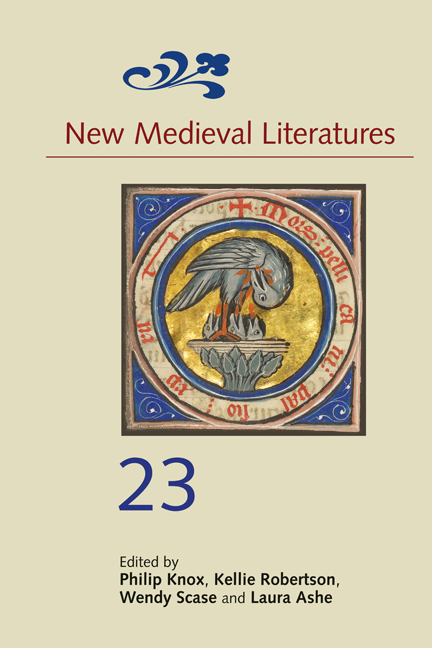Book contents
- Frontmatter
- Contents
- List of Illustrations
- Editors’ Note
- List of Abbreviations
- 1 A Paradox, (Un)Identified: Grendel’s Mother and the Lacanian Real
- 2 What Christ Might Say: Adapting the Last Judgment in the Prick of Conscience and Humbert’s De Dono Timoris
- 3 ‘At Jherusalem hyt ys goyd wyne’: The English Taste for the Sweet Blood of the Holy Land
- 4 The Bright Body: St Erkenwald’s Death Investigation
- 5 The Occasion of Chaucer’s Boece
- 6 ‘We axen leyser and espace’: Narrative Grace in Chaucer’s Franklin’s Tale and Melibee
- 7 The Shapes of the Speculum Christiani: Scribal Technique and Literary Aesthetics in Fifteenth-Century England
2 - What Christ Might Say: Adapting the Last Judgment in the Prick of Conscience and Humbert’s De Dono Timoris
Published online by Cambridge University Press: 11 January 2024
- Frontmatter
- Contents
- List of Illustrations
- Editors’ Note
- List of Abbreviations
- 1 A Paradox, (Un)Identified: Grendel’s Mother and the Lacanian Real
- 2 What Christ Might Say: Adapting the Last Judgment in the Prick of Conscience and Humbert’s De Dono Timoris
- 3 ‘At Jherusalem hyt ys goyd wyne’: The English Taste for the Sweet Blood of the Holy Land
- 4 The Bright Body: St Erkenwald’s Death Investigation
- 5 The Occasion of Chaucer’s Boece
- 6 ‘We axen leyser and espace’: Narrative Grace in Chaucer’s Franklin’s Tale and Melibee
- 7 The Shapes of the Speculum Christiani: Scribal Technique and Literary Aesthetics in Fifteenth-Century England
Summary
The Prick of Conscience famously aims to terrify, to ‘stir dread’ as a means of encouraging penance. Written in the first half of the fourteenth century, this 9,000-line poem was part of an outpouring of vernacular writing produced in response to thirteenth-century calls for pastoral reform. It survives in four different recensions, a whopping 130 manuscripts, and two sixteenth-century printed editions: despite a history of neglect among modern scholars, the widespread medieval appeal of this grim poem is undeniable.2 Much of the poem's dread stirring concerns the pains of purgatory and hell, pains the poet wishes to help readers avoid or mitigate by redirecting themselves heavenward. Divided into seven books, the Prick of Conscience examines the wretchedness of this life; the pains of death, hell, and purgatory; and the chaos and destruction of the end of time. One of the poem's strategies for scaring readers straight is to stoke their fears about the misery of damnation; even book seven, which ostensibly concentrates on the joys of heaven, ends up cycling back to the terror of hell. But the poem also works to stoke readers’ fear of missing out by highlighting the benefits of salvation, including the opportunity to commune with the divine at the end of time. Readers of the Prick of Conscience were surely familiar with standard Last Judgment iconography – the image of God in Judgment, separating the saved from the damned, was depicted on many a chancel arch in parish churches all over England. The moment was widely dramatized in cycle drama, and its biblical source, Matthew 25, was explicated from the pulpit and in a wide variety of vernacular texts. The Conscience-poet works within the context of these familiar tropes and narratives, but often in surprising and unconventional ways; one of his most innovative additions to this traditional subject is the representation of salvation as an opportunity to survey the sites of the Passion with none other than Christ himself as tour guide.
As I argue here, this is one of many ways that the Prick of Conscience puts topography to theological use. For the conscientious, reform-minded reader, the poem's symbolic afterlife landscapes become readable objects of interpretation, new opportunities for understanding the Last Judgment and the end of time from a theological perspective.
- Type
- Chapter
- Information
- New Medieval Literatures 23 , pp. 44 - 65Publisher: Boydell & BrewerPrint publication year: 2023



